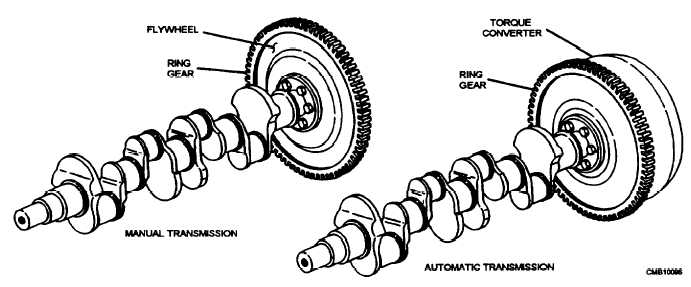the same manner. They all use a two-piece design The differences in design are in how the two pieces are linked together. One type of damper links the pieces together by an adjustable friction clutch. Whenever a suddenchange in crankshaft speed occurs, it causes the friction clutch to slip. This is because the outer section of the damper tends to continue at the same speed. The slippage of the clutch acts to absorb the torsional vibration. Another type of damper links the two pieces together with rubber. As the crankshaft speeds up, the rubber compresses, storing energy. This minimizes the effect of crankshaft speed increase. As the crankshaft unwinds, the damper releases energy stored in the compressed rubber to cushion the speed change in the other direction.
Flywheel
The flywheel (fig. 3-45) stores energy from the power strokes and smoothly delivers it to the drive train of the vehicle between the engine and the transmission. It releases this energy between power impulses, assuring fewer fluctuations in speed and smoother engine operation. The flywheel is mounted at the rear of the crankshaft near the rear main bearing. This is usually the longest and heaviest main bearing in the engine, as it must support the weight of the flywheel.
The flywheel on large, low-speed engines is usually made of cast iron. This is desirable because the heavy weight of the cast iron helps the engine maintain a steady speed. Small, high-speed engines usually use a forged steel or forged aluminum flywheel for the following reasons:
The cast iron is too heavy, giving it too much inertia for speed variations necessary on small engines.
Cast iron, because of its weight, pulls itself apart at high speeds due to centrifugal force.
When equipped with a manual transmission, the flywheel serves to mount the clutch With a vehicle that is equipped with an automatic transmission, the flywheel supports the front of the torque converter. In some configurations, the flywheel is combined with the torque converter. The outer edge of the flywheel carries the ring gear, either integral with the flywheel or shrunk on. The ring gear is used to engage the drive gear on the starter motor for cranking the engine.
VALVE AND VALVE MECHANISMS
There are two valves for each cylinder in most engines - one intake and one exhaust. Since these valves operate at different times, it is necessary that a separate operating mechanism be provided for each valve. Valves are held closed by heavy springs and by compression in the combustion chamber. The purpose of the valve actuating mechanism is to overcome spring pressure and open the valve at the proper time. The valve actuating mechanism includes the engine camshaft, the camshaft followers (tappets), the pushrods, and the rocker arms.

Figure 3-45. - Flywheel.
Continue Reading